人教版七年级下册期末复习U3-U4(共35张PPT)
文档属性
| 名称 | 人教版七年级下册期末复习U3-U4(共35张PPT) |  | |
| 格式 | pptx | ||
| 文件大小 | 14.0MB | ||
| 资源类型 | 教案 | ||
| 版本资源 | 人教新目标(Go for it)版 | ||
| 科目 | 英语 | ||
| 更新时间 | 2024-06-07 22:15:15 | ||
图片预览


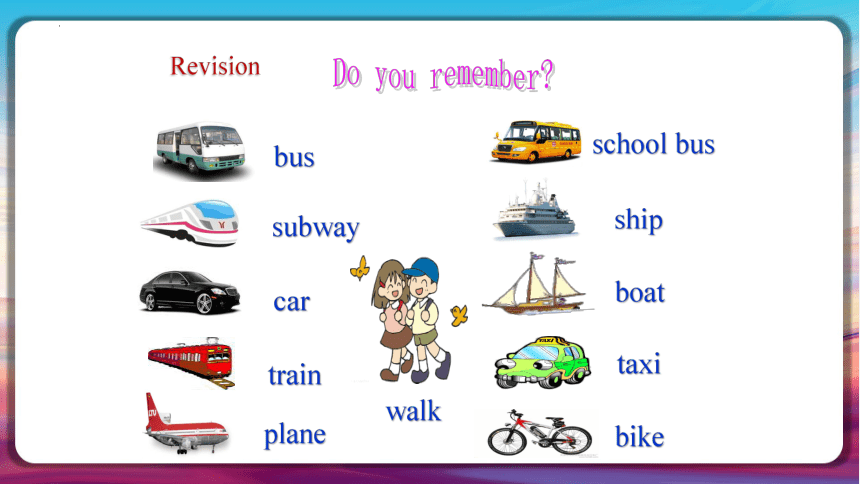
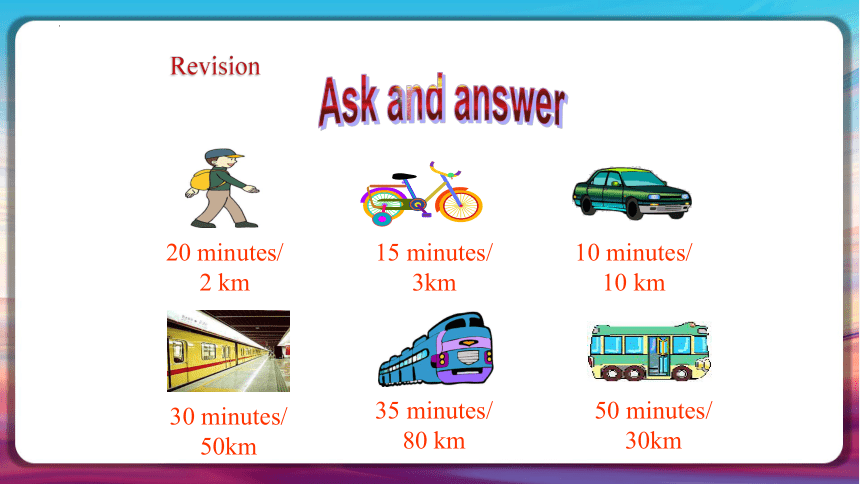
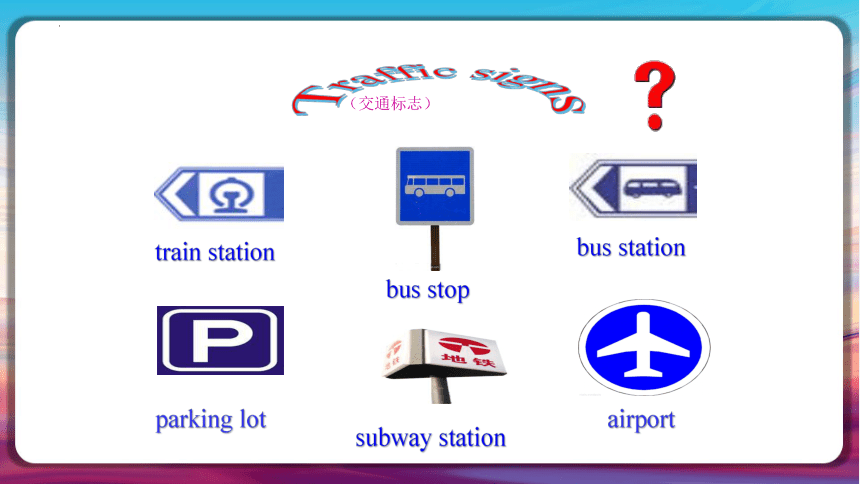
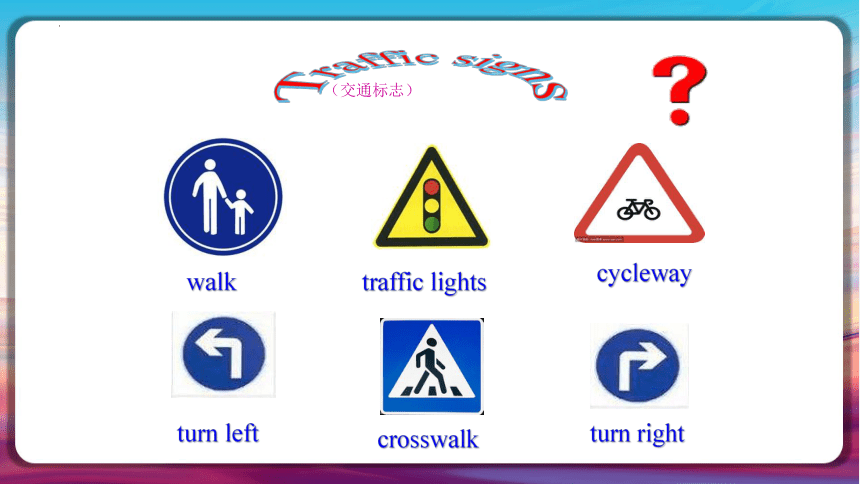

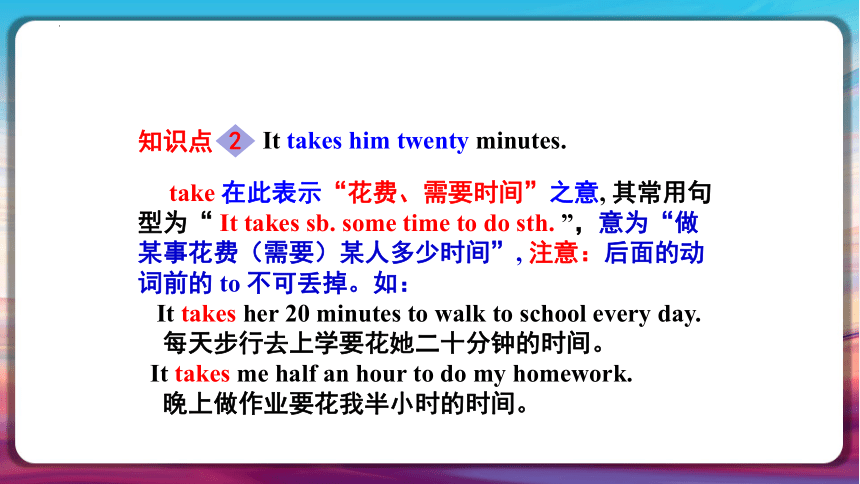
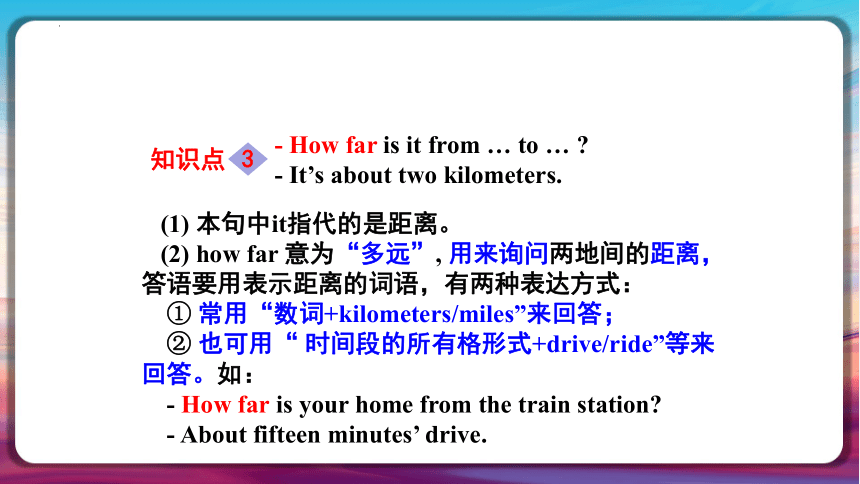
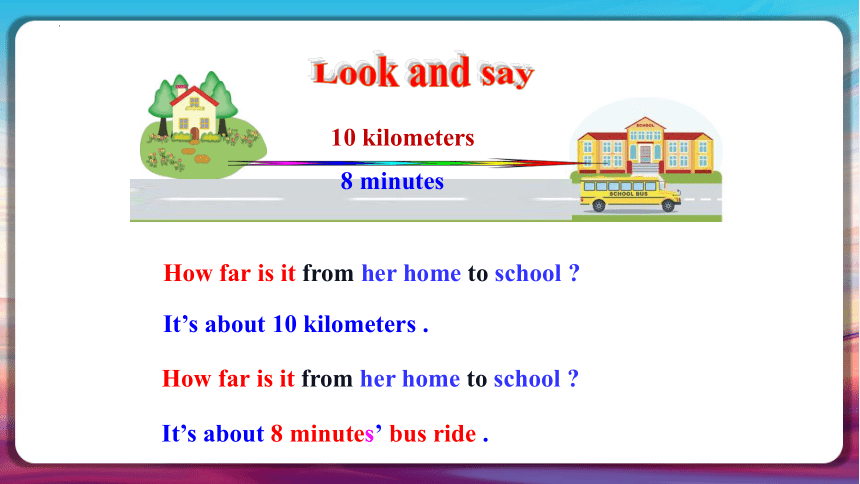
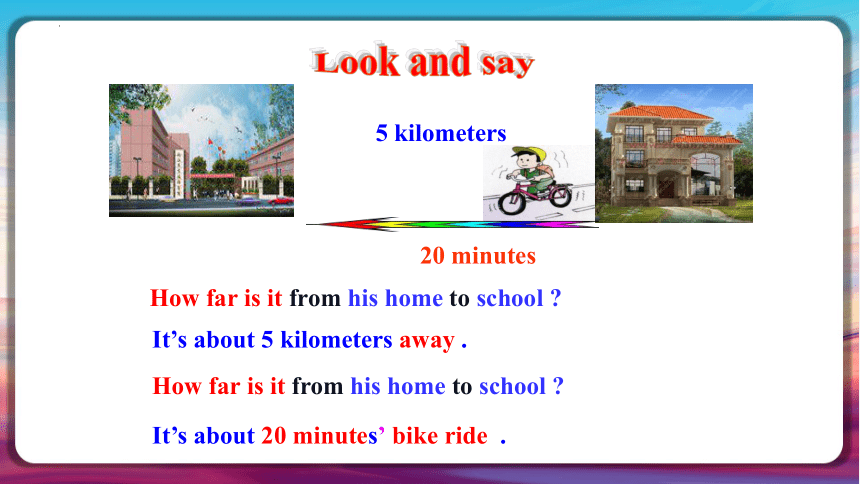

文档简介
(共35张PPT)
2024人教版七下
期末复习
U3-U4
U3
01
train
plane
car
school bus
Do you remember
bus
subway
ship
bike
taxi
boat
Revision
walk
35 minutes/
80 km
15 minutes/
3km
30 minutes/
50km
10 minutes/
10 km
50 minutes/
30km
20 minutes/
2 km
Ask and answer
Revision
Traffic signs
(交通标志)
train station
bus stop
parking lot
bus station
subway station
airport
walk
traffic lights
crosswalk
cycleway
turn left
turn right
Traffic signs
(交通标志)
how long意为 “多长时间”,用来询问时间的长短。如:- How long does it take to get to the library
- Half an hour by bike..
【拓展】
how long 还可表示 “多长”,用来询问物品的长度。
如:- How long is this river
- It’s about 150 kilometers.
知识点
1
How long does it take
take 在此表示“花费、需要时间”之意, 其常用句型为“ It takes sb. some time to do sth. ”,意为“做
某事花费(需要)某人多少时间”, 注意:后面的动
词前的 to 不可丢掉。如:
It takes her 20 minutes to walk to school every day.
每天步行去上学要花她二十分钟的时间。
It takes me half an hour to do my homework.
晚上做作业要花我半小时的时间。
It takes him twenty minutes.
知识点
2
(1) 本句中it指代的是距离。
(2) how far 意为“多远”, 用来询问两地间的距离,
答语要用表示距离的词语,有两种表达方式:
① 常用“数词+kilometers/miles”来回答;
② 也可用“ 时间段的所有格形式+drive/ride”等来
回答。如:
- How far is your home from the train station
- About fifteen minutes’ drive.
- How far is it from … to …
- It’s about two kilometers.
知识点
3
10 kilometers
How far is it from her home to school
It’s about 10 kilometers .
How far is it from her home to school
8 minutes
It’s about 8 minutes’ bus ride .
Look and say
How far is it from his home to school
It’s about 20 minutes’ bike ride .
It’s about 5 kilometers away .
20 minutes
5 kilometers
How far is it from his home to school
Look and say
1. How do/does + 某人 + ___________
某人怎么去某地
how是疑问副词, 本句用来对__________提问 。
eg: 你叔叔怎样去香港?
___________________________________
探究乐园
出行方式
get to 某地
How does your uncle get to Hong Kong
2. 回答方式有两种:
A: 某人 + take(s) + ____________ + to 某地。
B: 某人 + get(s) to 某地 + _____________
eg: 我叔叔乘飞机去香港。
___________________________________
___________________________________
the 交通工具
by 交通工具
My uncle takes the plane to Hong Kong.
My uncle gets to Hong Kong by plane.
3. it takes sb. some time to do sth.
意为:___________________________
步行大约要花我15 分钟的时间。
_________________________________
做作业大约花费简30分钟的时间。
_______________________________________
It takes me about 15 minutes to walk.
It takes Jane 30 minutes to do her homework.
干某事花费某人……时间
4. 如果对时间段提问的话,就用
_________ + does it take sb. to do sth. 句型。
How long
How long does it take to walk to school
How long does it take to do her homework
步行去上学需要多长时间?
做作业需要她多长时间?
5. 用下列句型对两地间的距离进行提问:
_______ + is it _____ 某地 ___ 某地?
eg: 从他家到服装店多远?
_______ is it _____ his home __ the clothes
store
从北京到上海有多远?
_______ is __ from Beijing ___ Shanghai
How far
from to
to
How far it
How far
from to
U4
02
Rules
餐厅规则
校规
class rules
班规
违反规则
keep rules
break rules
遵守规则
What rules do you know in your school
Revision
dining rules
school rules
what else?
Do 型(用动词原型开头)
1
Don’t + 动词原型
2
We must + 动词原型
3
We can't +动词原型
4
We have to + 动词原型
5
How to express rules
Rules
Summary
Do you know the rules for the school library
No talking!
Don’t talk.
Be quiet.
Presentation
Don’t take photos here.
Do you know the rules for the school library
No photos !
Presentation
We can’t take photos here.
“No+ V-ing”的祈使句,通常用于公共场所禁止、警告的提示语,尤其是用在标牌、布告等,表示“禁止做某事”。例如:
No parking! 不准停车!
No smoking, please! 请勿吸烟!
也可用 No + 名词的形式。例如:
No photos! 禁止拍照!
Tips
Summary
比眼力!
We can talk after class.
Don’t talk in class.
We can’t talk in class.
Tell your classmate what the rules should be.
What do you say to him
1. Hallway “走廊,过道”
2. Outside “外面”
① 作副词,意为“在外面,向外面”,常单独作
状语。如:
Please don’t look outside. Look at the blackboard.
② 作介词,意为“在……的外面”,后跟表示地
点或处所的名词。如:
They often take a walk outside the school.
Language points
3. wear a hat 戴帽子
wear v. 意思是“穿着;戴着 ”, 表示穿的状态,后
接从头上到脚底的所有衣服,以及饰品,如手表,
眼镜,徽章等,还可以表示“留(头发),蓄(胡须)”。
The girl often wears a red coat and a white hat.
这个女孩经常穿着红色的上衣戴着白色的帽子。
Does he wear glasses
他戴眼镜吗?
Language points
Language points
wear, put on,dress 与 be in 的区别
1. put on 意为“穿上”, 着重于“穿”这一动作,
即由没穿到穿这一过程的完成。动副短语,代
词作宾语,只能放到中间。如:
Please put on your new coat. 请穿上你的新大衣。
These are your new shoes , put them on.
Language points
wear, put on,dress 与 be in 的区别
2. dress 作及物动词,意为“给……穿衣服”,常由人作宾语,而不是衣服。如:
Could you dress the child for me
你能不能替我给小孩穿上衣服
还可作不及物动词,意为“穿衣,打扮”。e.g.
She is dressing for the party.
当表示自己穿衣服时,一般用:
get dressed = dress oneself 。如:
He cannot get dressed = He cannot dress himself.
当dress表示状态时,一般要用“be dressed in”的
形式,后接衣服或表示颜色的词。如:
She is dressed in a red coat.
Language points
wear, put on,dress 与 be in 的区别
3. in是介词,后接表示衣服或颜色的词,着重于服
装的款式或颜色。它所构成的短语只能作表语或
定语。
This is a picture of a young man in black .
这是一张穿着黑衣服的年轻人的照片。
He is in a black jacket today.
今天他穿着黑色夹克。
Language points
wear, put on,dress 与 be in 的区别
1.定义:
表示请求、命令、建议、叮嘱、号召、劝
告等的句子。
⒉ 特点:
这类句子的主语常是第二人称you,也就是
听话者,因而you常省去了,因此以动词原形开
头。
Grammar
祈使句
Summary
⒊ 种类:有肯定和否定两种:
⑴ 肯定:以动词原形开头。e.g.
Come in, please! 请进!
Sit down, please. 请坐。
⑵ 否定:在动词原形前加 Don't。 e.g.
Don't talk in class! 不要在课常上讲话!
Don't open the window! 别开窗!
Don’t smoke! 别吸烟!
祈使句
Grammar
Summary
1. Don’t arrive late for class. 不要上课迟到。
Language points
1)arrive vi. “到达”,是一个不及物动词,不能
直接跟表示地点的名词。如果要跟名词,就必须加
介词in或at。在大地方前加in(国家、城市等),在
小地方前加at(家、学校、商店等)。
We'll arrive in Shanghai tomorrow morning.
明天早上我们将到达上海。
We usually arrive at the village in the morning.
我们通常在早上到那个小村庄。
将下面的句子改为祈使句,每空一词。
1. You can come in.
______ ____, please.
2. I can help you.
_____ me ______ you.
3. You can’t eat in class.
_______ _____ in class.
4. You can’t be late for school.
______ ____ late for school.
5. Take the pen to your sister. (改为否定句)
______ ______ the pen to your sister.
6. Don’t arrive late next time. (改为同义句)
_______ ____ late next time..
Come in
Let help
Don’t eat
Don’t be
Exercises
Exercise
Don’t take
Don’t be
单选(每题2分,共12分)
( )1. The doctor says to Tom “____ get up too late.”
A. Doesn’t B. Can’t C. Don’t D. No
( )2. Don’t arrive late _____ class.
A. at B. for C. in D.\
( )3. Don’t ______ music in class.
A. listen B. listen to C. listen at D. hear
( )4. It’s important to be _______ for the meeting.
A. on time B. in time C. all the time D. at times
( )5. When will she _____ Shanghai
A. arrives B. arrive in C. get D. gets
C
B
B
A
B
Exercises
thanks
2024人教版七下
期末复习
U3-U4
U3
01
train
plane
car
school bus
Do you remember
bus
subway
ship
bike
taxi
boat
Revision
walk
35 minutes/
80 km
15 minutes/
3km
30 minutes/
50km
10 minutes/
10 km
50 minutes/
30km
20 minutes/
2 km
Ask and answer
Revision
Traffic signs
(交通标志)
train station
bus stop
parking lot
bus station
subway station
airport
walk
traffic lights
crosswalk
cycleway
turn left
turn right
Traffic signs
(交通标志)
how long意为 “多长时间”,用来询问时间的长短。如:- How long does it take to get to the library
- Half an hour by bike..
【拓展】
how long 还可表示 “多长”,用来询问物品的长度。
如:- How long is this river
- It’s about 150 kilometers.
知识点
1
How long does it take
take 在此表示“花费、需要时间”之意, 其常用句型为“ It takes sb. some time to do sth. ”,意为“做
某事花费(需要)某人多少时间”, 注意:后面的动
词前的 to 不可丢掉。如:
It takes her 20 minutes to walk to school every day.
每天步行去上学要花她二十分钟的时间。
It takes me half an hour to do my homework.
晚上做作业要花我半小时的时间。
It takes him twenty minutes.
知识点
2
(1) 本句中it指代的是距离。
(2) how far 意为“多远”, 用来询问两地间的距离,
答语要用表示距离的词语,有两种表达方式:
① 常用“数词+kilometers/miles”来回答;
② 也可用“ 时间段的所有格形式+drive/ride”等来
回答。如:
- How far is your home from the train station
- About fifteen minutes’ drive.
- How far is it from … to …
- It’s about two kilometers.
知识点
3
10 kilometers
How far is it from her home to school
It’s about 10 kilometers .
How far is it from her home to school
8 minutes
It’s about 8 minutes’ bus ride .
Look and say
How far is it from his home to school
It’s about 20 minutes’ bike ride .
It’s about 5 kilometers away .
20 minutes
5 kilometers
How far is it from his home to school
Look and say
1. How do/does + 某人 + ___________
某人怎么去某地
how是疑问副词, 本句用来对__________提问 。
eg: 你叔叔怎样去香港?
___________________________________
探究乐园
出行方式
get to 某地
How does your uncle get to Hong Kong
2. 回答方式有两种:
A: 某人 + take(s) + ____________ + to 某地。
B: 某人 + get(s) to 某地 + _____________
eg: 我叔叔乘飞机去香港。
___________________________________
___________________________________
the 交通工具
by 交通工具
My uncle takes the plane to Hong Kong.
My uncle gets to Hong Kong by plane.
3. it takes sb. some time to do sth.
意为:___________________________
步行大约要花我15 分钟的时间。
_________________________________
做作业大约花费简30分钟的时间。
_______________________________________
It takes me about 15 minutes to walk.
It takes Jane 30 minutes to do her homework.
干某事花费某人……时间
4. 如果对时间段提问的话,就用
_________ + does it take sb. to do sth. 句型。
How long
How long does it take to walk to school
How long does it take to do her homework
步行去上学需要多长时间?
做作业需要她多长时间?
5. 用下列句型对两地间的距离进行提问:
_______ + is it _____ 某地 ___ 某地?
eg: 从他家到服装店多远?
_______ is it _____ his home __ the clothes
store
从北京到上海有多远?
_______ is __ from Beijing ___ Shanghai
How far
from to
to
How far it
How far
from to
U4
02
Rules
餐厅规则
校规
class rules
班规
违反规则
keep rules
break rules
遵守规则
What rules do you know in your school
Revision
dining rules
school rules
what else?
Do 型(用动词原型开头)
1
Don’t + 动词原型
2
We must + 动词原型
3
We can't +动词原型
4
We have to + 动词原型
5
How to express rules
Rules
Summary
Do you know the rules for the school library
No talking!
Don’t talk.
Be quiet.
Presentation
Don’t take photos here.
Do you know the rules for the school library
No photos !
Presentation
We can’t take photos here.
“No+ V-ing”的祈使句,通常用于公共场所禁止、警告的提示语,尤其是用在标牌、布告等,表示“禁止做某事”。例如:
No parking! 不准停车!
No smoking, please! 请勿吸烟!
也可用 No + 名词的形式。例如:
No photos! 禁止拍照!
Tips
Summary
比眼力!
We can talk after class.
Don’t talk in class.
We can’t talk in class.
Tell your classmate what the rules should be.
What do you say to him
1. Hallway “走廊,过道”
2. Outside “外面”
① 作副词,意为“在外面,向外面”,常单独作
状语。如:
Please don’t look outside. Look at the blackboard.
② 作介词,意为“在……的外面”,后跟表示地
点或处所的名词。如:
They often take a walk outside the school.
Language points
3. wear a hat 戴帽子
wear v. 意思是“穿着;戴着 ”, 表示穿的状态,后
接从头上到脚底的所有衣服,以及饰品,如手表,
眼镜,徽章等,还可以表示“留(头发),蓄(胡须)”。
The girl often wears a red coat and a white hat.
这个女孩经常穿着红色的上衣戴着白色的帽子。
Does he wear glasses
他戴眼镜吗?
Language points
Language points
wear, put on,dress 与 be in 的区别
1. put on 意为“穿上”, 着重于“穿”这一动作,
即由没穿到穿这一过程的完成。动副短语,代
词作宾语,只能放到中间。如:
Please put on your new coat. 请穿上你的新大衣。
These are your new shoes , put them on.
Language points
wear, put on,dress 与 be in 的区别
2. dress 作及物动词,意为“给……穿衣服”,常由人作宾语,而不是衣服。如:
Could you dress the child for me
你能不能替我给小孩穿上衣服
还可作不及物动词,意为“穿衣,打扮”。e.g.
She is dressing for the party.
当表示自己穿衣服时,一般用:
get dressed = dress oneself 。如:
He cannot get dressed = He cannot dress himself.
当dress表示状态时,一般要用“be dressed in”的
形式,后接衣服或表示颜色的词。如:
She is dressed in a red coat.
Language points
wear, put on,dress 与 be in 的区别
3. in是介词,后接表示衣服或颜色的词,着重于服
装的款式或颜色。它所构成的短语只能作表语或
定语。
This is a picture of a young man in black .
这是一张穿着黑衣服的年轻人的照片。
He is in a black jacket today.
今天他穿着黑色夹克。
Language points
wear, put on,dress 与 be in 的区别
1.定义:
表示请求、命令、建议、叮嘱、号召、劝
告等的句子。
⒉ 特点:
这类句子的主语常是第二人称you,也就是
听话者,因而you常省去了,因此以动词原形开
头。
Grammar
祈使句
Summary
⒊ 种类:有肯定和否定两种:
⑴ 肯定:以动词原形开头。e.g.
Come in, please! 请进!
Sit down, please. 请坐。
⑵ 否定:在动词原形前加 Don't。 e.g.
Don't talk in class! 不要在课常上讲话!
Don't open the window! 别开窗!
Don’t smoke! 别吸烟!
祈使句
Grammar
Summary
1. Don’t arrive late for class. 不要上课迟到。
Language points
1)arrive vi. “到达”,是一个不及物动词,不能
直接跟表示地点的名词。如果要跟名词,就必须加
介词in或at。在大地方前加in(国家、城市等),在
小地方前加at(家、学校、商店等)。
We'll arrive in Shanghai tomorrow morning.
明天早上我们将到达上海。
We usually arrive at the village in the morning.
我们通常在早上到那个小村庄。
将下面的句子改为祈使句,每空一词。
1. You can come in.
______ ____, please.
2. I can help you.
_____ me ______ you.
3. You can’t eat in class.
_______ _____ in class.
4. You can’t be late for school.
______ ____ late for school.
5. Take the pen to your sister. (改为否定句)
______ ______ the pen to your sister.
6. Don’t arrive late next time. (改为同义句)
_______ ____ late next time..
Come in
Let help
Don’t eat
Don’t be
Exercises
Exercise
Don’t take
Don’t be
单选(每题2分,共12分)
( )1. The doctor says to Tom “____ get up too late.”
A. Doesn’t B. Can’t C. Don’t D. No
( )2. Don’t arrive late _____ class.
A. at B. for C. in D.\
( )3. Don’t ______ music in class.
A. listen B. listen to C. listen at D. hear
( )4. It’s important to be _______ for the meeting.
A. on time B. in time C. all the time D. at times
( )5. When will she _____ Shanghai
A. arrives B. arrive in C. get D. gets
C
B
B
A
B
Exercises
thanks
同课章节目录
